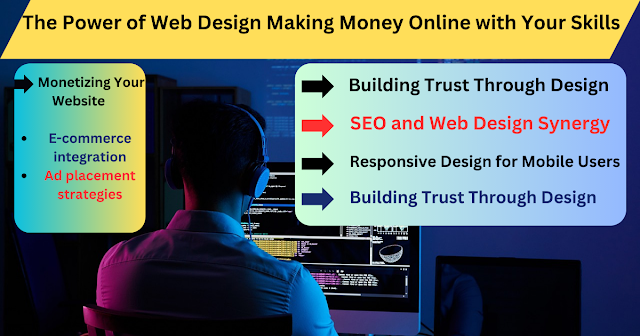Web Design Making Money Online:
Introduction
The importance of web design in the era of digital
Connecting web design with online income
We live in a digital age where the internet is a constant in our everyday lives, so site design is important. User experiences are greatly influenced by a website's appearance and usability. and, surprisingly, they can also be a lucrative avenue for making money online.
Table of Content
1. Crafting an Engaging Website
- Importance of user-friendly design
- Navigational simplicity
2. SEO and Web Design Synergy
- Integrating keywords seamlessly
- Optimizing images and multimedia
3. Responsive Design for Mobile Users
- The growing mobile audience
- Google's mobile-first indexing
4. Building Trust Through Design
- Professionalism in aesthetics
- Trust signals in web design
5. Monetizing Your Website
- E-commerce integration
- Ad placement strategies
6. The Impact of Page Speed on Conversions
- Google's page speed algorithm
- User experience and bounce rates
7. Web Design Trends for 2024
- Predictions and staying ahead
- Balancing trends with functionality
8. Leveraging Social Media Integration
- Expanding your online presence
- Social sharing and SEO benefits
9. Data Security and Privacy
- The importance of SSL certification
- User trust and data protection
10. Case Studies: Successful Web Design Ventures
- Examining real-world success stories
- Learning from industry leaders
11. Overcoming Challenges in Web Design
- Common hurdles and solutions
- The iterative process of improvement
12. The Future of Web Design Careers
- Emerging opportunities
- Evolving skill sets
13. E-commerce Integration and Strategies
- Seamless Transaction Experiences
- Diversifying Revenue Streams
14. Harnessing the Power of Content Marketing
- Quality Content Creation
- Blogging for Authority
15. Community Engagement and Feedback
- Building a Community
- Valuing User Feedback
16. Adapting to Technological Advances
- AI and Personalization
- Voice Search Optimization
17. Navigating Challenges in Monetization
- Balancing Ads and User Experience
- Adapting to Algorithm Changes
18. Conclusion
- Summarizing the power of web design
- Encouraging readers to take action
Crafting an Engaging Website
Importance of User-Friendly Design:
- The foundation of web design is the user experience. Not only does a user-friendly design draw in visitors, but it also maintains their interest. A well-structured and intuitive layout enhances the overall experience, encouraging users to explore and return.
Navigational Simplicity
- Simplicity in navigation is key. Users should effortlessly find what they're looking for. Clear menus and logical organization contribute to a seamless journey through your website, increasing the chances of conversion.
SEO and Web Design Synergy
Integrating Keywords Seamlessly
- Effective SEO is a game-changer for online visibility. Weave relevant keywords naturally into your content, headers, and metadata. This synergy between design and SEO boosts search engine rankings, bringing in natural visitors to your website.
Optimizing Images and Multimedia
- Visual appeal is crucial, but it shouldn't compromise loading speed. Optimize images and multimedia elements to strike a balance between aesthetics and performance, ensuring a positive user experience.
Responsive Design for Mobile Users
The Growing Mobile Audience
- Mobile users constitute a significant portion of internet traffic. Make sure your website is responsive, meaning it will work on a range of devices. Google's mobile-first indexing prioritizes mobile-friendly sites, impacting search rankings.
Google's Mobile-First Indexing
- Google's algorithm prioritizes mobile-friendly websites, recognizing the prevalence of mobile browsing. Embrace responsive design to enhance visibility and accessibility, catering to the diverse needs of users.
Building Trust Through Design
Professionalism in Aesthetics
- A visually appealing website reflects professionalism. Invest in high-quality design elements, that align with your brand identity. A polished appearance instills trust in visitors, increasing the likelihood of conversion.
Trust Signals in Web Design
- Incorporate trust signals such as client testimonials, security badges, and clear contact information. These elements reassure users, fostering a sense of credibility and reliability.
Monetizing Your Website
E-commerce Integration
- For individuals wishing to market goods or services online, seamless e-commerce integration is essential. Optimize product pages, simplify the checkout process, and explore digital marketing strategies to boost sales.
Ad Placement Strategies
- If monetizing through ads, strategic placement is key. Balance ad density to avoid overwhelming users. Native advertising and unobtrusive placements can generate income without compromising user experience.
The Impact of Page Speed on Conversions
Google's Page Speed Algorithm
- Page speed directly influences user satisfaction and conversions. Google prioritizes fast-loading sites, impacting search rankings. Optimize your website's performance to reduce bounce rates and improve overall user experience.
User Experience and Bounce Rates
- A slow website can drive users away. Minimize bounce rates by ensuring swift loading times. Prioritize content delivery, optimize code, and leverage content delivery networks (CDNs) for enhanced speed.
Web Design Trends for 2024
Predictions and Staying Ahead
- Web design is an ever-evolving field. Stay ahead by anticipating trends. However, balance is crucial; prioritize functionality over fleeting aesthetics. A timeless, user-centric approach ensures long-term success.
Balancing Trends with Functionality
- While embracing trends, ensure they align with your website's purpose. Strive for a harmonious blend of contemporary design and practical functionality. This approach ensures your site remains relevant and effective.
Leveraging Social Media Integration
Expanding Your Online Presence
- Using social media to increase your reach can be quite effective. Integrate social sharing buttons, allowing users to easily share your content. Leverage various platforms to connect with your audience and drive traffic.
Social Sharing and SEO Benefits
- Social signals impact SEO. Engage in social sharing to enhance your website's visibility. Sharing is encouraged by high-quality content that connects with your audience. amplifies your online presence, and improves search rankings.
Data Security and Privacy
The Importance of SSL Certification
- User trust hinges on data security. Invest in SSL certification to encrypt data transmitted between users and your website. A secure connection not only protects user information but also positively influences search rankings.
User Trust and Data Protection
- Clearly communicate your commitment to user privacy. Put in place strong data security safeguards and clear privacy guidelines. Building trust is crucial for retaining visitors and encouraging repeat interactions.
Case Studies: Successful Web Design Ventures
Examining Real-World Success Stories
- Explore case studies of successful web design ventures. Analyze their strategies, design choices, and marketing approaches. Learning from industry leaders provides valuable insights for your own online endeavors.
Learning from Industry Leaders
- Successful websites often share common traits. Identify patterns among industry leaders, adapting strategies that align with your goals. To prosper in the ever-changing digital landscape, one must constantly learn new things and adapt.
Overcoming Challenges in Web Design
Common Hurdles and Solutions
- Web design comes with its challenges. Identify common hurdles such as technical issues, user experience gaps, or outdated design elements. Provide practical solutions to empower readers to overcome these obstacles.
The Iterative Process of Improvement
- Web design is an iterative process. Embrace a mindset of continuous improvement. Regularly assess user feedback, analyze website analytics, and implement changes to enhance user experience and achieve your online goals.
The Future of Web Design Careers
Emerging Opportunities
- Explore the evolving landscape of web design careers. Identify emerging opportunities, such as specialization in augmented reality (AR), virtual reality, reality (VR), or voice user interface (VUI) design. Keep up with changes in the industry and develop skills that are in line with the evolving needs of the digital environment.
Evolving Skill Sets
- As technology evolves, so do the skills required in web design. Stay ahead by honing your skills in areas like artificial intelligence (AI) integration, UX/UI design, and responsive web development. Adapting to emerging technologies ensures your relevance in the competitive web design field.
E-commerce Integration and Strategies
Seamless Transaction Experiences
- In the realm of making money online, e-commerce integration plays a pivotal role. Ensure your website provides a seamless transaction experience for users. Streamline the checkout process, offer secure payment options, and prioritize user-friendly product pages.
Diversifying Revenue Streams
- Beyond traditional e-commerce, explore additional revenue streams. Consider affiliate marketing, sponsored content, or creating premium content behind a paywall. Diversifying your income sources safeguards against market fluctuations and opens up new opportunities.
Harnessing the Power of Content Marketing
Quality Content Creation
- Content remains king, and a well-crafted content marketing strategy can amplify the impact of your web design efforts. Provide insightful, valuable content that appeals to your target market. This not only enhances user engagement but also contributes to improved search engine rankings.
Blogging for Authority
- Maintain an active blog to establish yourself as an authority in your niche. Share insights, tips, and industry trends. Regularly updated, informative content not only attracts visitors but also encourages repeat visits and boosts your website's credibility.
Community Engagement and Feedback
Building a Community
- Foster a sense of community around your website. Encourage user engagement through comments, forums, or social media. A vibrant online community not only enhances user experience but also creates a loyal audience that can champion your brand.
Valuing User Feedback
- User input is an important source for ongoing development. Implement feedback mechanisms such as surveys or user testing to understand your audience better. Addressing user concerns and suggestions demonstrates a commitment to providing an optimal user experience.
Adapting to Technological Advances
AI and Personalization
- Embrace technological advances like artificial intelligence to enhance user interactions. Implement chatbots for customer support and personalized recommendations based on user behavior. These elements contribute to a more tailored and engaging user experience.
Voice Search Optimization
- Making your website voice search-friendly is becoming more and more crucial as voice-activated gadgets proliferate. To match the way consumers engage with voice search, employ conversational tones and natural language in your content.
Navigating Challenges in Monetization
Balancing Ads and User Experience
- When incorporating ads on your website, strike a balance between monetization and user experience. Steer clear of advertising that impedes the user's path. Prioritize user satisfaction to maintain a positive reputation and encourage return visits.
Adapting to Algorithm Changes
- Stay vigilant to changes in search engine algorithms and advertising platforms. Adapt your strategies accordingly to ensure continued visibility and effectiveness in your online monetization efforts.
Conclusion
In conclusion, the power of web design goes beyond creating visually appealing websites. It is a dynamic tool that, when wielded effectively, can be a gateway to online success and financial gain. By combining user-centric design, SEO optimization, and strategic monetization, individuals can turn their web design skills into a lucrative online business.FAQ.
1. How can I make my website more user-friendly?
- Prioritize clear navigation and intuitive design.
- Optimize for mobile responsiveness to cater to a diverse audience.
- 2. What are effective content marketing strategies for web designers?
- Focus on creating valuable, relevant content.
- Maintain an active blog to showcase expertise and engage your audience.
- 3. How can I balance ads on my website without compromising user experience?
- Prioritize non-intrusive ad placements.
- Monitor user feedback and adjust ad strategies accordingly.
- 4 What role does community engagement play in online success?
- Building a community fosters brand loyalty.
- User feedback from the community provides insights for improvement.
- 5. How do technological advances like AI impact web design?
- AI enhances user interactions through chatbots and personalization.
- Stay abreast of AI trends to incorporate relevant features into your web design.










Please do not enter any spam link in the comment box.